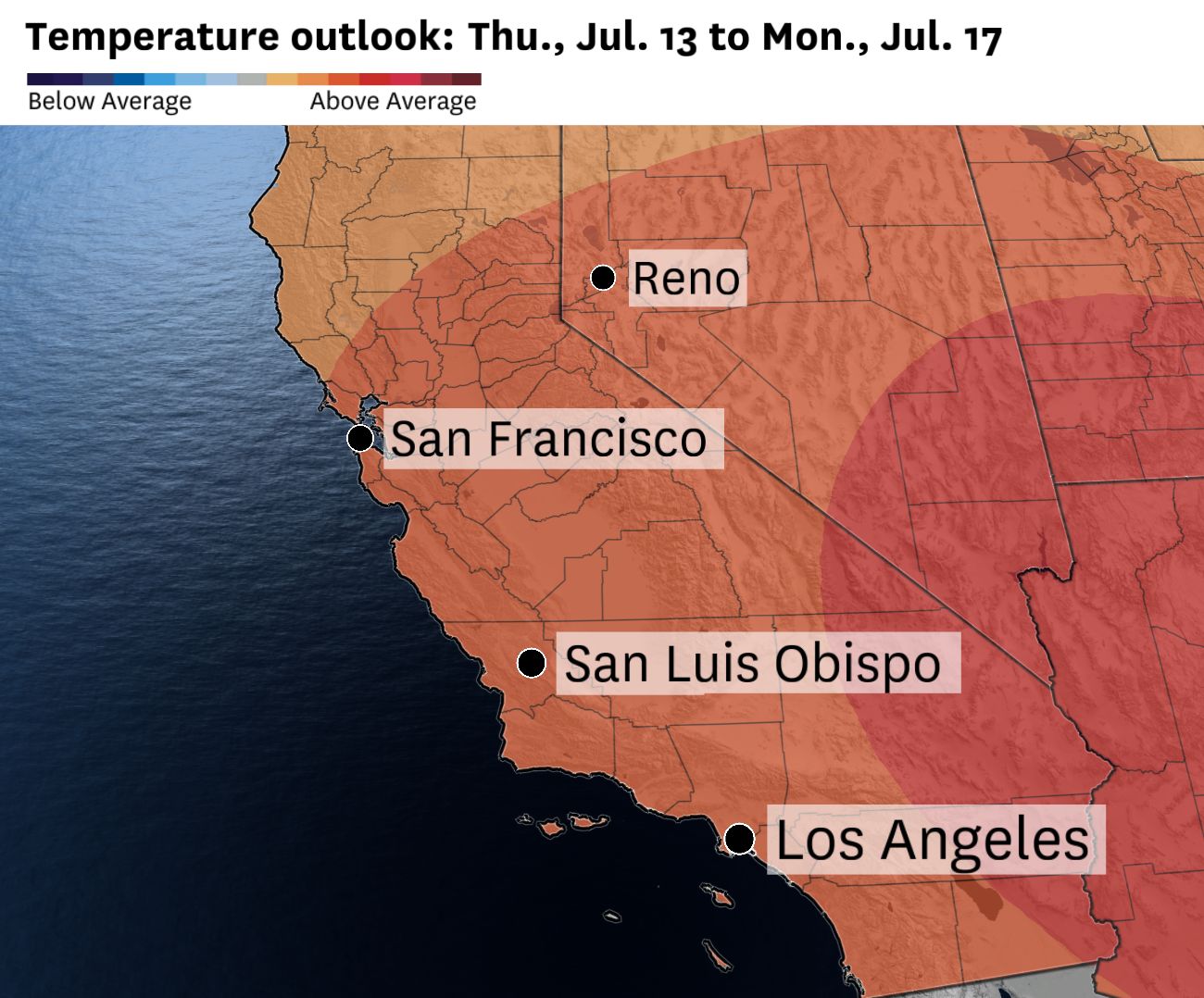Heat wave is heading for California. Here’s a timeline of impacts
Triple-digit temperatures in the deserts of Mexico will creep into the Southwest United States over the next few days, setting off a chain of events that could evolve into Northern California’s next significant heat wave.
Makings of a heat wave
An area of high pressure over Northern Mexico will begin to draw excessive heat from the Sonoran Desert into California starting Monday.
Hot desert air will begin to overrun the San Joaquin Valley by Tuesday, raising temperatures to the 100s in cities like Bakersfield and Fresno, then continuing to expand the rest of the week as far north as Redding.
Triple-digit heat isn't unheard of for Northern California in July, but it is unusual to have long stretches this early in the summer.
“The setup is somewhat September-like, and confidence has increased in hot temperatures for the slopes and inland valleys,” wrote Sean Miller, a lead meteorologist at NWS Bay Area and Monterey.
A timeline of potential impacts
Based on guidance from both weather models and the National Weather Service, it looks like a long stretch of hotter than average weather will take off on Tuesday in the Sacramento Valley and Wednesday in the Bay Area.
Simulations on both the European and American weather models lean toward temperatures running 5 to 7 degrees above average for this time of year across Northern California. This means high temperatures could surpass 100 degrees in cities like Stockton and Sacramento by Wednesday, while San Francisco will be a balmy 70 degrees.
NWS Sacramento lead meteorologist Eric Kurth expects to see a ridging pattern over Northern California by midweek. This means that the high pressure system has a good chance of raising several days worth of excessive heat. “We are projecting a return to moderate heat risk Tuesday and Wednesday,” Kurth wrote.
Weatherbell
Some of that moderate heat risk has a chance of expanding into the Bay Area’s inland valleys starting Tuesday afternoon. And like exhaust from traffic on a busy freeway, hot air — shaded in warm, red hues on the graphic above — will begin to clog up the region.
Both the European and American models predict daytime temperatures could easily reach the lower to mid-90s in inland cities like Livermore, Santa Rosa and Dublin between Tuesday and Wednesday. The constant flow of heat from the high pressure system will then compound over the Bay Area’s inland valleys, raising the odds of temperatures in the upper 90s to lower 100s by Thursday.
“This will lead to warming temperatures and the potential for excessive heat, particularly for inland areas,” Miller wrote. “The scope appears to be similar, if not greater, than the heat event last weekend.”
This weather setup also raises concerns about prolonged heat risk for vulnerable populations. A couple of days of hot weather can be a nuisance, but longer stretches raise concerns about heat-related illnesses. Residents who plan to be outside for long periods of time, especially between the hours of 11 a.m. and 5 p.m., should consider making trips to cooling shelters or seeking shade.
What about the coast?
Weather models paint an uncertain picture of how the hot weather will impact the San Francisco Bay and Pacific coast by Thursday.
“Our position along the northwest periphery of the upper high still leaves coastal areas a bit more vulnerable to the cooling influence of onshore flow,” Miller wrote.
A small wobble in the high-pressure system could mean the difference between daytime temperatures reaching the upper 80s or staying closer to the 70s in cities like San Francisco and Oakland. For now, the odds are in favor of cool Pacific winds shielding the coast and the bay from the worst of the heat this week.
Because of all the moving parts involved in this weather setup, the forecast becomes riddled with uncertainties after Friday. The Weather Wonks will monitor this developing story as we get closer to the heat event.
Saturday breakdown
San Francisco: Sunshine will be hard to come by this morning. A cool and humid weather pattern will maintain patches of fog and a chance of drizzle on the west side through 1 p.m., while San Franciscans east of Sutro Tower can expect partly sunny skies by 11 a.m.
Intermittent clouds will keep daytime temperatures 1 to 3 degrees below average for this time of year — in the lower 60s on the west side and mid-60s elsewhere.
Marine fog will then make a comeback tonight along the coast, Golden Gate Bridge and hillsides. Look for nighttime lows in the lower to mid-50s.
East Bay: High fog on the Oakland and Berkeley hills will likely last through 11 a.m., while sunshine slowly returns to the Tri-Valley area by noon. Daytime highs have a good chance of reaching the mid-70s in Walnut Creek, Dublin and Pleasanton, while cooler air west of the Caldecott Tunnel will keep highs closer to the upper 60s in bay shore cities like Richmond, Hayward and Alameda.
A bay breeze will gust to 20 mph, reeling in marine clouds to the shore by the evening. Look for more cool, humid air after 7 p.m. and for nighttime temperatures in the mid- to upper 50s.
North Bay: Residents sleeping in might miss some of this morning’s fog. The Napa, Santa Rosa and Petaluma valleys can expect a quick return to sunshine after 9 a.m, though some clouds might hang around in the highlands. Most of Wine Country will see partly cloudy skies and a breezy afternoon with highs in the mid-70s.
Chillier air by the coast will keep afternoon temperatures around Point Reyes and Bodega Bay closer to 60. The same goes for Marin County cities along the bay, where upper 60s are on tap for Tiburon and Sausalito. That said, inland cities like Novato and San Rafael can expect a burst of warmth from mostly sunny skies that will raise highs into the lower 70s.
Marine clouds will return to the bay shore and inland valleys tonight. Look for nighttime temperatures in the mid-50s.
Pacific Coast and Peninsula: Clouds, drizzle and fog are likely to persist along Highway 1 for most of the day, though a few breaks of sunshine could return in the afternoon. The rest of the Peninsula can expect high fog for much of the morning and sunnier skies in the afternoon.
Winds will gust to 30 mph on the coast, meaning coastal places like Daly City, Pacifica and Miramar can expect daytime highs near 60. Lighter winds and more widespread sunny skies will allow temperatures to reach the lower 70s along the I-280 and Highway 101 corridor. Residents in the San Bruno Gap — Millbrae, San Mateo and South San Francisco — will be in a “Goldilocks zone” between the cool and warm air this afternoon, with highs likely to hit the mid-60s.
Marine clouds will reclaim the Peninsula after sunset, keeping nighttime lows in the mid- to upper 50s.
South Bay and Santa Cruz: The inland valleys and mountain communities can expect sunshine to come back after 11 a.m. Look for daytime temperatures near 70 degrees in Felton, Scotts Valley and Ben Lomond and lower 70s in San Jose. That said, downtown San Jose may experience mid-70s just before a light bay breeze arrives after 2 p.m.
Fog along the immediate shoreline will persist until 1 p.m. Look for partly cloudy skies along Highway 1 and afternoon highs in the lower 60s for cities like Capitola, La Selva and Aptos.
Marine clouds and fog over Monterey Bay will eventually make their way inland again, raising humidity levels as nighttime temperatures fall to the mid-50s.
Source: San Francisco Chronicle


